The half-width switch space is very popular. There are two major advantages. One can deploy redundant switches in 1U of rack space which makes for more compact installations, especially with smaller clusters. It also generally costs less for smaller lower port count switches. Addressing this market is the Netgear M4300-8X8F we are reviewing today. With eight SFP+ and eight 10Gbase-T ports, the M4300-8X8F has 16-ports total with a lot of flexibility. The technical model number for the M4300-8X8F is the XSM4316S which is at least going to make some STH readers smile. Sometimes you need to replace a string of numbers and letters representing a model with another string of numbers and letters representing the same model. For our review, that we are going to continue below, we are simply going to refer to this as the M4300-8X8F.
Netgear M4300-8X8F Hardware Overview
One of the most interesting aspects of the M4300-8X8F is that it is a half-width switch. Practically this means that the switch can be mounted side-by-side with a second switch. With some mounting bracket work, one could conceivably be mounted next to servers such as the Lenovo ThinkSystem SE350 we reviewed as well. Either scenario packs a lot of capability into 1U of rack space either offering both a SD-WAN platform, two 10GbE switches, or a single lower-cost switch option in space-constrained racks.

Our rack ear was slightly damaged during the multiple shipments that got it here. During the shelter-in-place 2020 order, Netgear shipped the switch and it got misdirected in shipping which caused it to go almost across the entire US twice to get to us instead of traveling a 10-minute drive down Silicon Valley roads. The box was in bad shape but the switch was perfectly fine. The rack ear we did not even notice got slightly bent until we looked at photos. It was easy to bend and get working, but we did not want to use the photos of slightly bent rack ears. Instead, here are the single and dual switch mounting options from Netgear which shows how this could also work if we had two switches.
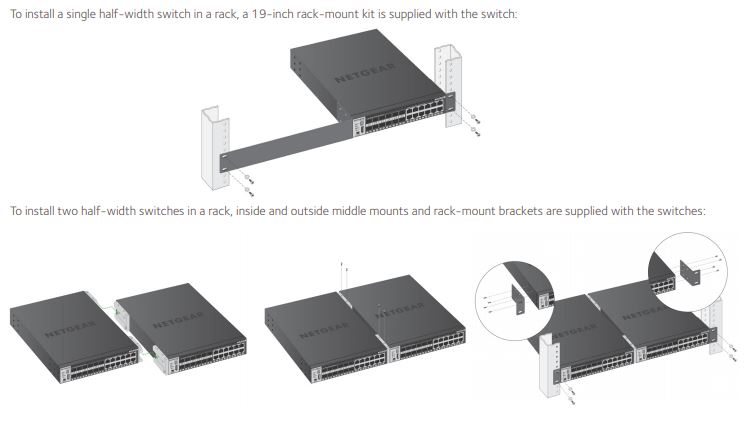
The left side of the switch has standard LED status indicators. There is also a recessed reset switch. One nice feature is that Netgear prints the baud rate (115200) of the serial console directly on the switch. This may seem like a small and easy feature, but it is something we wish all companies would do. It saves having to search later for this. While there is a mini USB port for console, but there is a second USB port. This USB Type-A primarily for management such as updating switch firmware.
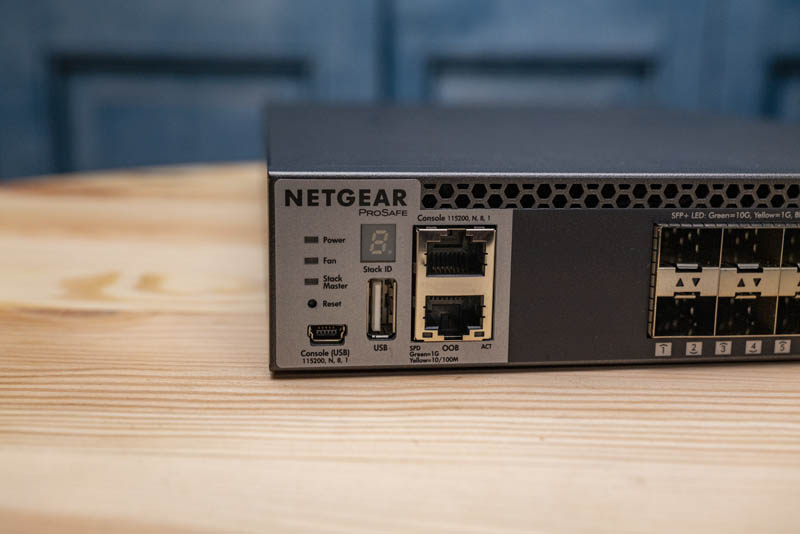
Two other features we wanted to point out. One can see that there is a Stack ID LED as well as a Stack Master indicator. These small switches are stackable. They can be stacked with other M4300-8X8F switches, but also other switches in the M4300 line. That makes deployment and administration slightly easier. One can even use any of the switch ports to do the stacking.
The other major feature is that this switch has an out-of-band management port labeled OOB. This is a fairly standard feature on higher-end switches. While Netgear is following the industry standard in this regard, Ubiquiti cuts this out of even their 25GbE “data center” models just to save pennies. Netgear here made the right design choice since OOB management ports are extremely useful and this is a feature the industry expects.
The switch ports are set in two blocks. There are eight SFP+ and eight 10Gbase-T ports. As a result, we have a total of sixteen 10GbE ports on the switch which is denoted by the model number’s “8X8F” string. These ports can throttle down to 1Gbps speeds and the RJ45 ports can also handle 100M speeds if you absolutely need that feature.
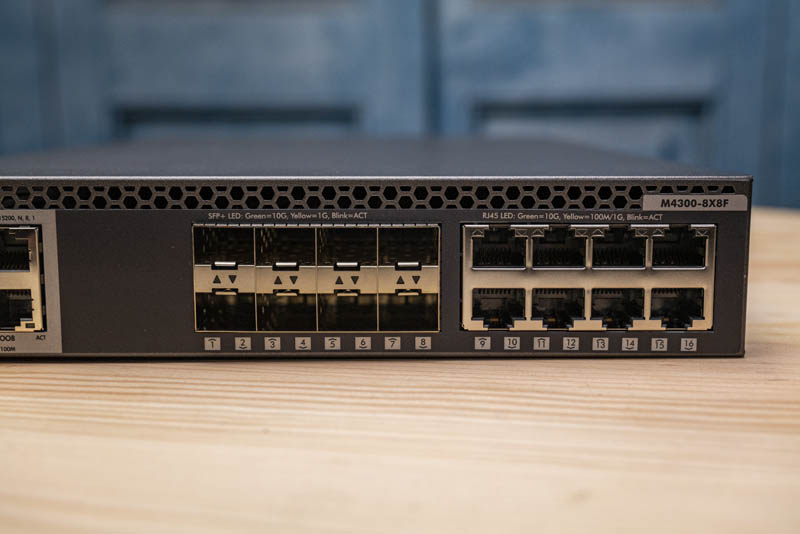
The rear of the switch is very simple. There is a label with serial number, model, and MAC address information. In the middle, there is a fan exhaust. On the side, one can see the power supply. Other than power and to potentially look at the label, there is nothing else on the rear of the switch so almost all servicing will be done via the front of the unit.
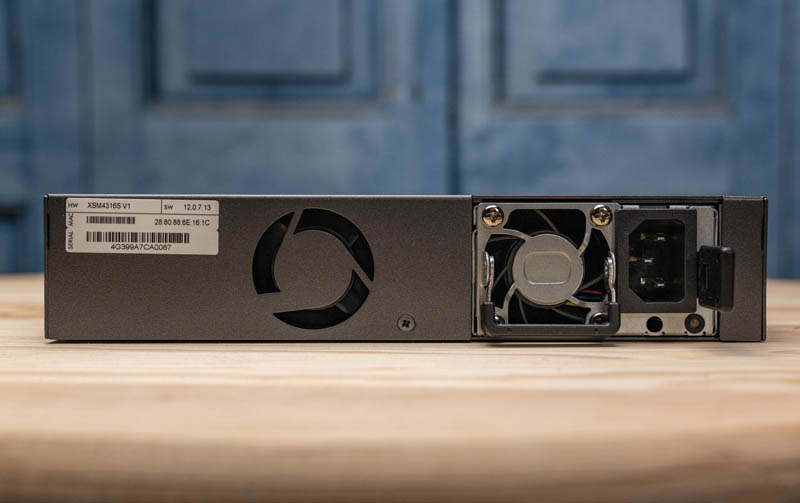
The power supply is not redundant, but it is field replaceable. We tested, and you can insert the PSU with a power cable attached to power up the machine so it is hot-pluggable as well. Since there is only one PSU, if you do swap the power supply, the switch will power off. Non-redundant power supplies in the half-width space are extremely common. As an example, in our Dell X4012 12-port 10GbE half-width switch review, we saw Dell’s 12-port 10GbE offering have a single internal PSU without the ability to service the CPU externally. Netgear’s solution is a notable improvement.
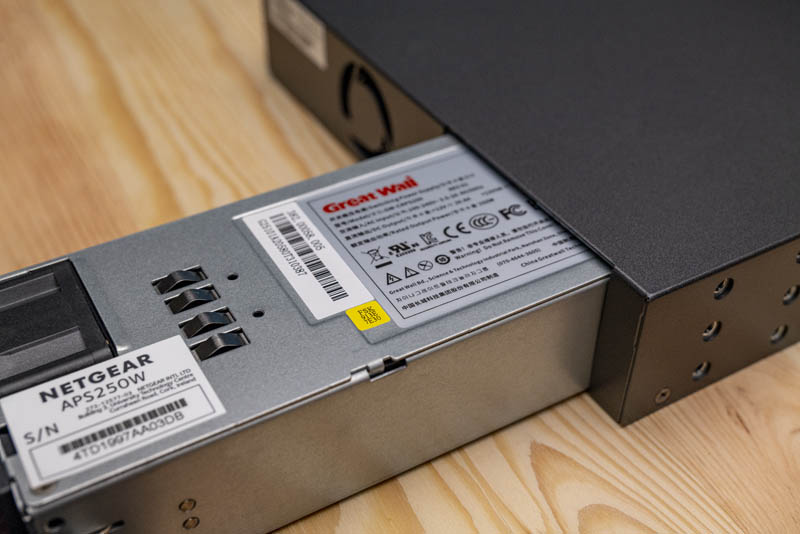
The power supply is the Netgear APS250W manufactured by Great Wall. We see Great Wall power supplies even in very high-end server designs such as our recent Inspur NF5488M5 AI training server review.
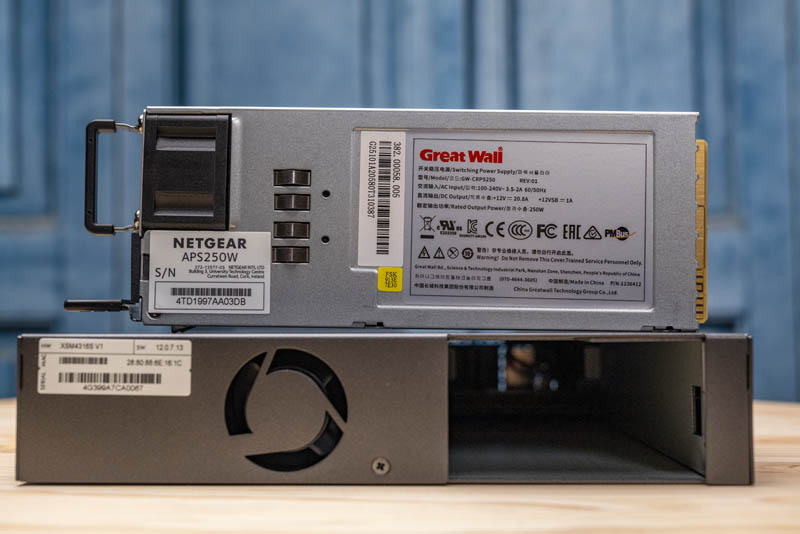
The reason we are using this product shot is also that one can see through the PSU area through the front of the chassis. Near the management port, the M4300-8X8F has vents to help facilitate airflow. The power supply is designed to move air through the chassis over components inside the chassis as well. One can see the blue background through the switch in this shot. Netgear clearly designed the switch with significant thought around getting proper airflow.
Taking a look inside the chassis, we see the switch ports and I/O in the front, we see the main pieces of silicon including the CPU and switch chips on the PCB. In the rear, we see power and cooling.
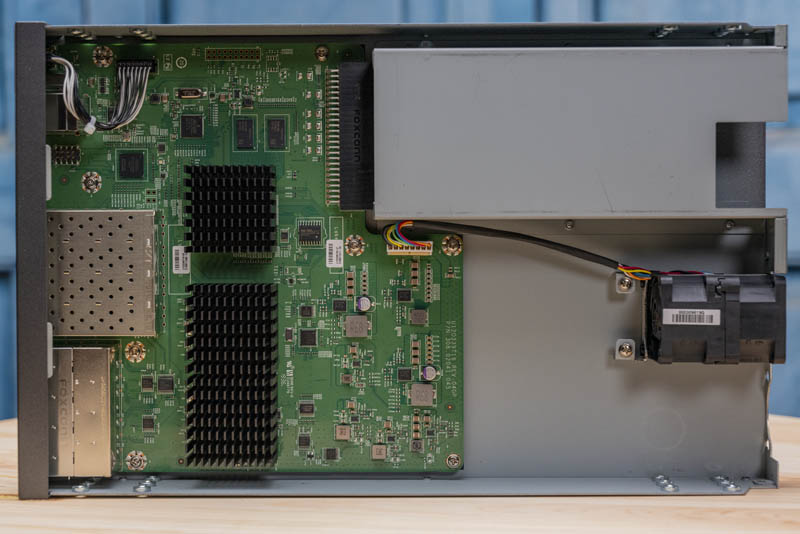
Like many higher-end switches, we have a management processor onboard the switch. Netgear does not disclose the switch chip nor the processor being used. One can see “bcm” references in the CPU processes. Still, we feel that it is important to publicly document the switch chips and CPUs used. Ever since the Intel Atom C2000 Series Bug the industry has increased its focus on providing this information. Since these switches are provided with a lifetime warranty, it is something buyers should have easy access to.
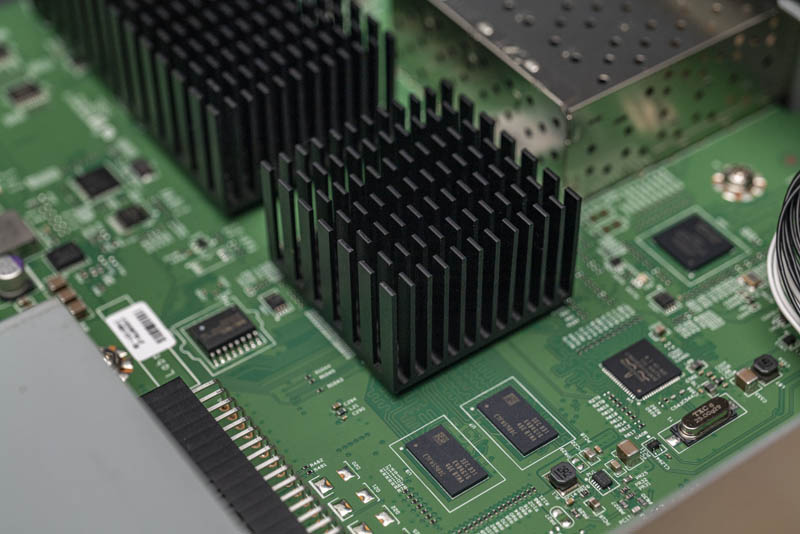
One can see the RJ45 and SFP+ cages neatly aligned on the front of the PCB.
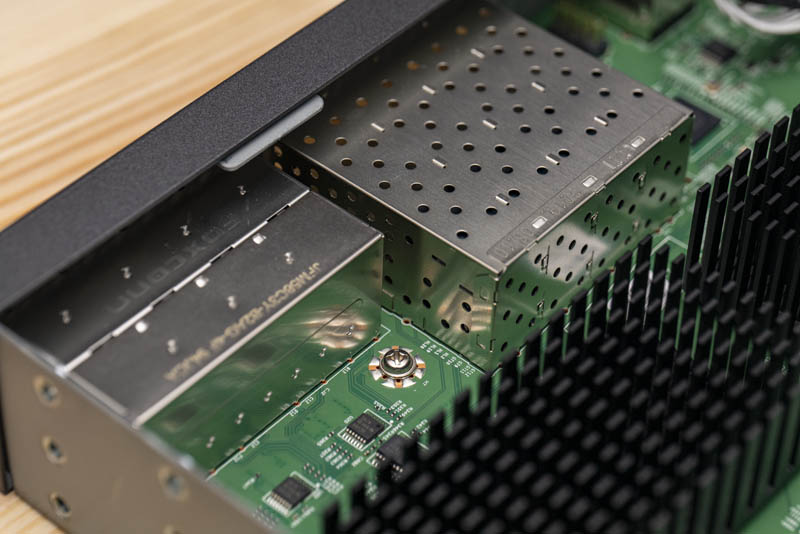
Since we took photos before testing and did not want to have the conversation of “we broke the switch trying to take heatsinks off,” we wanted to show this view. In some of the photos, above this array looks like a single large heatsink. Instead, it is actually two heatsinks on two different packages. This was not an easy photo to take but that means that there are three packages with large heatsinks inside the chassis.
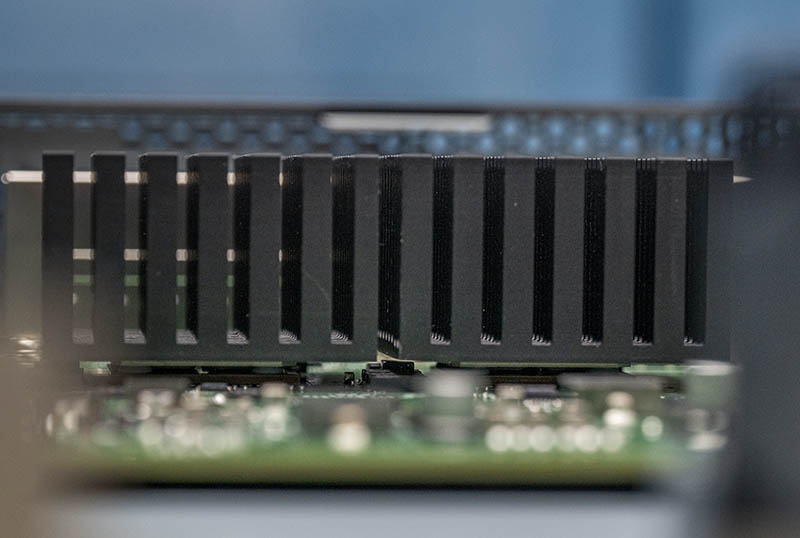
Inside the chassis, next to where we took this photo, we find a nice Nidec UltraFlow fan arrangement. Netgear went with the double fan unit instead of using two separate fans which is an interesting design choice.
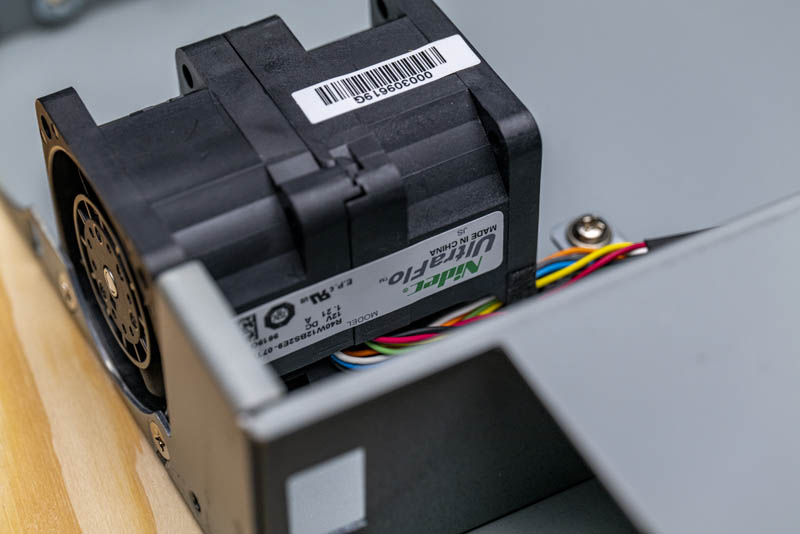
Overall this is a well-built switch. We wanted to also take a moment and point out a few small items that differentiate the MX4300-8X8F design from some of the lower-end options available.
Small Differentiators
First, we see an Altera controller onboard. This is going to seem like a strange item to note, but if you look at our switch reviews Altera and Xilinx parts are designed into higher-end switchgear while they are not utilized in lower-end switches to save costs. It may seem like a small detail, but when you are running a switch review series, it is a small detail you quickly notice.
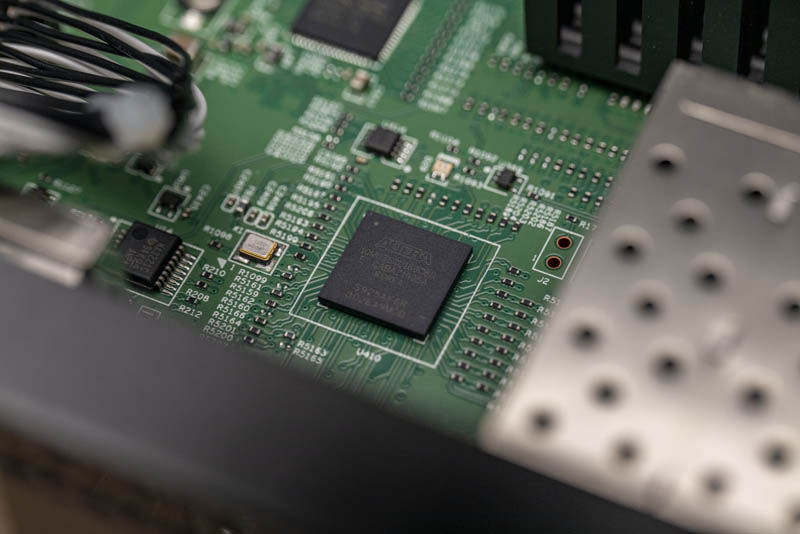
The mechanical design was simple, but Netgear did a great job. One example is that six mounting holes are in the front and the rear of the chassis. The chassis is made from relatively thick steel for a switch in this class. Even though this wall of the switch is covered by two steel panels, Netgear has added nice threaded screw ends to the chassis as well.
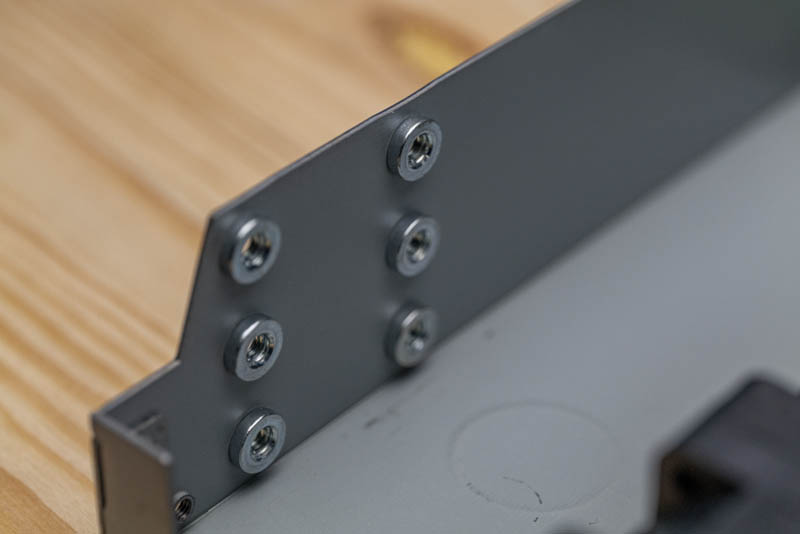
Another thoughtful bit was in the bag that protects the switch during shipping. There was a pre-cut hole for the PSU removal tab.
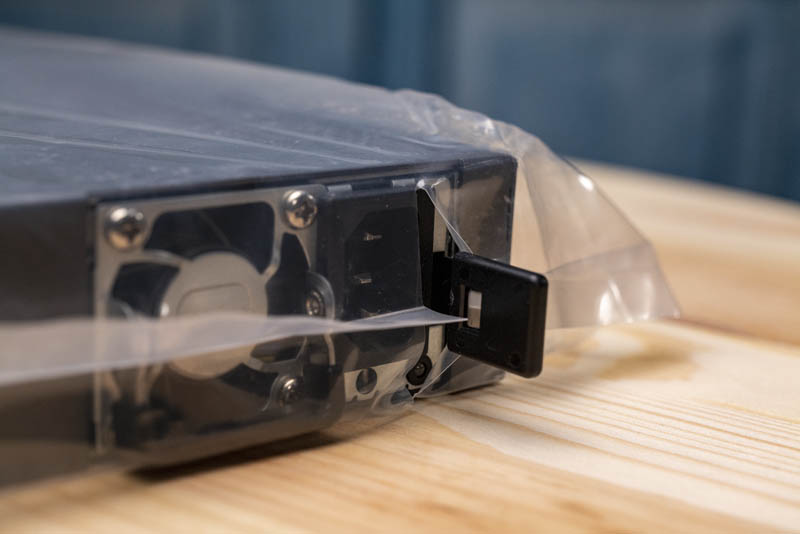
These may all seem like small items, but Netgear is perhaps most famous for its consumer sub-$20 switches and Wi-Fi gear. In our hardware overview, we wanted to point out some of these small design differentiators to show that Netgear is putting extra care into crafting a higher-end product with the M4300 line.
Next, we are going to look at the management, power consumption, performance, and discuss our final thoughts.

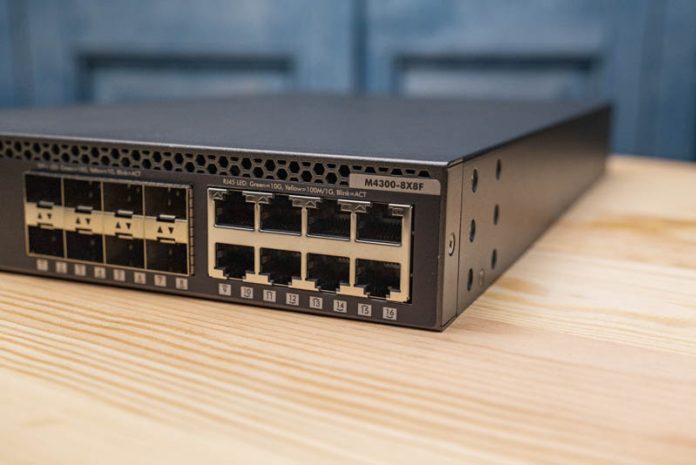



Grrrr, It would be perfect with the support of multigig.
1- Given that you would need to use 1 or 2 ports to bridge to another unit for a fault-tolerant network connections, I would suggest that the M4300-12X12F model (although more expensive) would be a better unit for most uses
2- This unit with 25Gbs SFP28 ports (instead of 10Gbs) would have been a “homerun”!
3- As noted, the fact that multi-gig is not supported is disappointing, especially when the M4300-16X supports multi-gig.
Looking at the Amazon reviews these units seem to have had serious issues early on, any further testing that STH did to validate these switches deliver what they claim? Reading a review that states stack failure in a recovering failover event is not confidence inspiring.
Also given that these switches have been around for a while it would be beneficial if you could at least list MSRP or similar when assigning a value score.
When I’m looking at the fully managed market for the price these switches are not at all interesting when comparing to equivalent half width switches like the S4112F-ON which offers better vendor/channel support and better integration with our network management tooling.
David, I talked to Rohit about this. On the stacking, bugs reported in 2016-2017 we only had one unit so it is not something we could test. At some point we have limits.
The major downside with these is the absolutely terrible stacking. It’s pathetically unreliable. Spent about £30,000 on these in work. For the stacking to be unusable. Crashes often and takes two minutes to failover, dropping connections when it does it. Joke.
Wanted to love them, but wish we’d gone with Cisco or Aruba for the stack switches.
Also this model had a fan issue for ages, reported on forums. Had poor responses and still not fixed properly.
Bs replies to feature requests.
It’s so cute!
We’ve got a bunch of these deployed 2 in 1U for quarter cab colos we’ve got around the world. We haven’t had any of the issues on those Amazon reviews. They’ve been great for us but maybe we’ve got something going on that’s different than other people? We’re also not mixing models.
I’ve used two of the 12x/12x last year.
They’re capable and Netgear is basically the only vendor serving this need – a small higher speed core with the port mix almost all SMB envs need.
The devil is in the details, a technologically dated OS that’s modelled after 15-20 year old Ciscos, where you still need to leave the main config session to change the ‘VLAN database’
a lot of fragility in DHCP relaying, it broke our backs since the windows guys just knew it doesn’t work 100% but couldn’t even produce traces.
Imho you can see where they had to stitch on enterprise features on top of what they’re used to and those bits are hurting.
I hope they can invest the time to redo those parts, but I also got the strong feeling that it’s not where the funding goes.
For that customer who only knows about web interfaces I would get them again. Otherwise I just hope that finally some other vendor catches up to this market segment instead of offering products for it that will NEVER be bought.
I’d have loved if any of the deterministic Ethernet features were tested. This switch has an interesting feature set and physical size that fits several use-cases that’d leverage those features.
I also presume that the Broadcom chip near the Altera FPGA is for the OOB port?
> As noted, the fact that multi-gig is not supported is disappointing,
> especially when the M4300-16X supports multi-gig.
This particular model was only added to their M4300 line last year, explains why the M4300-96X and 16X are the only models in the lineup with mGig support.
I have a couple of M4300 in use. Yes they did have bugs but I’ve had reasonably good experience with their support provided you send them debug logs etc.
Stacking has quite improved, especially the failover time like in releases last year. I did work with them on a mixed stack issue and I my case was well-handled and I was given a RC firmware in advance to test the improvements – after their first internal QA run.
Would I use M4300’s everywhere: No, but given the right use case (here: education) and price it’s still pretty OK. Also the lifetime warranty is a bonus compared to i.e. Ubiquiti. Also in Europe their stock situation has been better compared to Ubiquiti in a similar price bracket.
no GUI / CLI parity? that’s one of the reasons i bought my current netgear siwtch
Take note that lifetime warranty does not imply lifetime firmware updates.
If we don’t need a layer 3 but just layer 2/2+, is-there similar swicths on the market less expensive ?
Any chance we could get an updated review of a new model of the M4300-16X ? Either the XSM4316PB (PoE+) or XSM4316PA (PoE)
The newer ones are 16 MultiGbE Base-T ports that support PoE(+).
Other than the ridiculous price, it sounds like the perfect core switch for the prosumer/enthusiast network. It would allow for Wifi6/Wifi6E APs running over PoE+ while still having multi-GbE backhaul. Only downsides are price and noise.